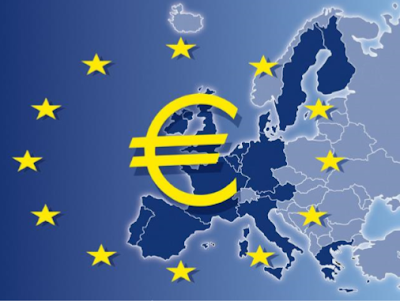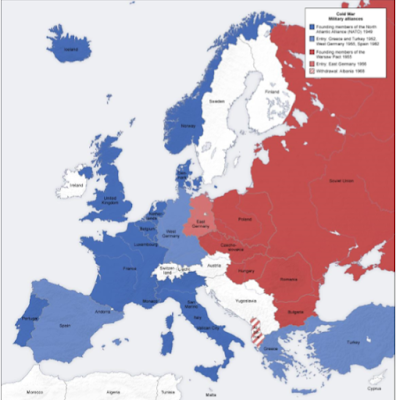The
Eurozone a Historical Perspective
To understand current events and my perspective on present European economy, a historical perspective must be approached. In Greek mythology Europa was the mother of King Minos of Crete, a woman with Phoenician origin of high lineage, and after whom the continent Europe was named. Many changes has Europe gone through in the last few decades, and also in it’s long and traditional history. But let us focus on the last 200 years, which is the historical period we are considering for this essay. This piece of work is orientated, after all, to the new industrial revolution and the changes this is bringing to the global economy. Check out this map of Europe from the 1800s:
We can come to many conclusions, just by looking at the map. Norway was not even a country since it was under union with Denmark. Germany, surprisingly to many maybe, was not a country either. The Germanic region was, only 200 years ago, a set or distributed small kingdoms with no political or economic influence in the region. Sweden was the largest empire, small in population, but very efficient. Prussia, which occupied to a large extent what is now Poland, was one of the most powerful empires, entering long wars against Sweden in the Baltic Sea. The zars were the rulers of the Russian empire, and even Napoleon himself feared them. Britain (including Ireland) was an imperialist kingdom with the strongest maritime fleet. Portugal and Spain were pretty much as today. France, in a post-revolution and Napoleonic time, was larger than it is today. Italy was confined to only southern Italy (or Naples). The Habsburgs were the richest and most powerful empire, extending through large part of Central Europe. And, last but not least, the Ottoman empire managed to conquer and occupy the Balcan region, Bulgaria and a part of Rumania. All of these considerations are key. My essay is based on the hypothesis that, even with government changes and different economical models, the human being and culture is more powerful than the impositions of local authorities. Consider the impact of religion as well. While Southern Europe is mainly catholic, Northern Europe is Lutheran and Eastern Europe mainly Orthodox. The influence of the Ottoman Empire can be seen even today in the Balcans or Bulgaria, were mosques are very common. Can someone really believe that a 4-year or 8-year period in the
government will bring big changes? Can political or economic systems bring big changes to society as a whole? The distribution of landscape in the beginning of the 1800s in Europe brings a very good description of what Europe is like even today. A region divided between the catholic south-europeans, the Lutheran north-europeans, the French (a different more equalitarian Christian as well), the central Europeans (also catholic), the eastern Europeans (mainly orthodox), and finally, the Islamic influence in the baltics. Relationships were tense between the different Christian groups, but with the formation of the Holy League in the late 1600s, which was an alliance of the Holy Roman Empire, Prussia and the Tsardom of Russia, all their differences were resolved in order to drive the advancing Ottoman Empire back to the Asiatic region. A succession of wars, including Napoleonic and the times of tsars in Russia, resulted in the following landscape, pre-World War 1:
We can see that the Ottoman Empire lost a large part of it’s influence, with the establishment of countries like Serbia, Bulgaria, Romania and the reappearance of Greece. France has lost some of it’s region, with the formation of Switzerland, Belgium and the Netherlands. Italy took today’s shape. Norway, still not an independent country, underwent a union with Sweden. But, probably most importantly, the appearance of Germany as a country, as opposed to a group of de
connected barbarian kingdoms. Notice that Prussia, which included Poland, disappeared entirely to become a part of Germany! I believe it is not necessary to dwell too much on the events that led to the formation of what is the present state of Europe. WW1, which joined Germany and the Austrian-Hungarian empire, and then WW2, an even tougher revival, laid the groundwork for today’s borders. The Soviet Union emerged as a superpower forming the Eastern Bloc, with Central Europe as region of influence. The Iron Curtain separated East from West. Yugoslavia (sometimes confused as part of the Soviet Bloc) was actually a socialist state that had good diplomatic and commercial relationships both with East and West. Germany itself was divided between East and West, with the iconic Berlin wall. In the same way the Western bloc secured the Latinamerican region by establishing puppet governments through dictatorships, the Soviet Union placed their own dictators in Central Europe. The case of Romania was the bloodiest, with dictator Nicolae Ceaușescu ruling the country for almost 35 years. As always in dictatorships, citizens had to be careful in which type of activities they engaged and what they were commenting, since any sort of anti-government movement was severely repressed and kidnappings were common ground.
The reconstruction of Western Europe was led by the US through what was called the “Marshall Plan”. The goals of the United States were to rebuild war-devastated regions, remove trade barriers, modernize industry, make Europe prosperous again, and prevent the spread of communism. The Marshall Plan required a lessening of interstate barriers, a dropping of many regulations, and encouraged an increase in productivity, labour union membership, as well as the adoption of modern business procedures. Besides being it’s military partner, Western Europe was also the US’ commercial partner. International commerce flourished, with countries specializing in different industries. Automotive (Italy, Germany, France), Clocks (Switzerland), Food & Tourism (Spain), Telecommunications (France, Italy, Sweden), Oil & Gas (Norway), are examples of industries each country was famous for. These countries engaged in commerce with each other, as well as with the US, forming a bloc that people know even today as “the West”, or developed Nations. Consider that Australia is also included in this bloc due to it’s ties with the UK, even if it is not part of the Western hemisphere. I will explain WHY in a later chapter. The fall of the Berlin Wall in 1989 and the dissolution of The Soviet Union gave way to Europe as we know it today. The Balcans war reformed the ex-Yugoslavia into several countries as well. You would think that the Balcanic countries are all the same, but no. Different languages, culture and history make it so that people from different ethnical groups in the Balcan region are sceptical of each other even today.
Formed in 1998, the Eurozone, officially called the euro area, is a monetary union of 19 of the 28 European Union (EU) member states which have adopted the euro (€) as their common currency and sole legal tender. The other nine members of the European Union continue to use their own national currencies. In 2007 – 2008, when the financial crisis burst in the USA, the weakest countries of the Eurozone enter recession. First it was Greece, then Spain, Italy, Ireland and Portugal, who are known as the PIIGS countries. In the next chapters, I will discuss the Euro Crisis in depth, but as always a historical perspective is needed before entering the field of economics.









No comments:
Post a Comment